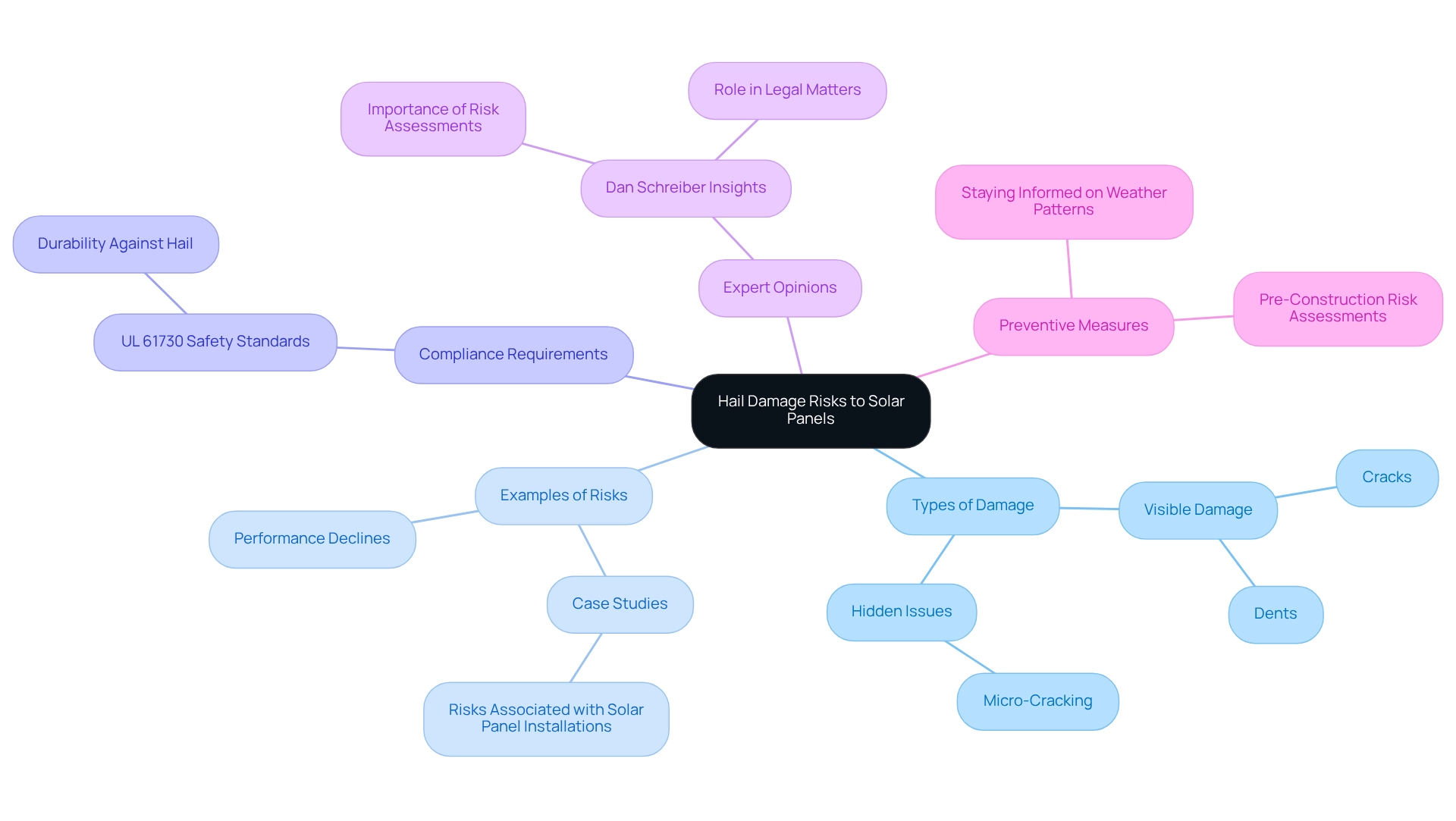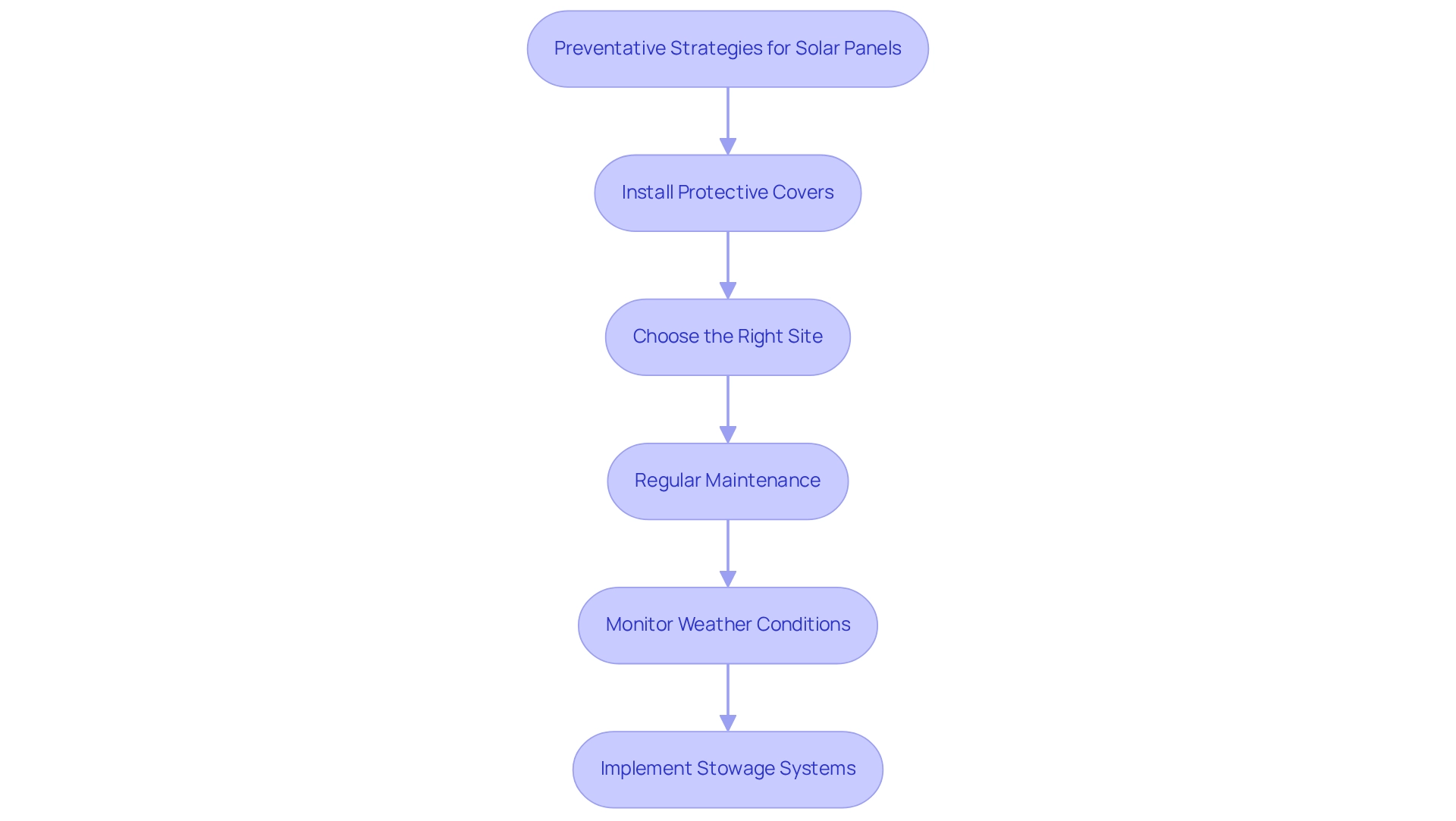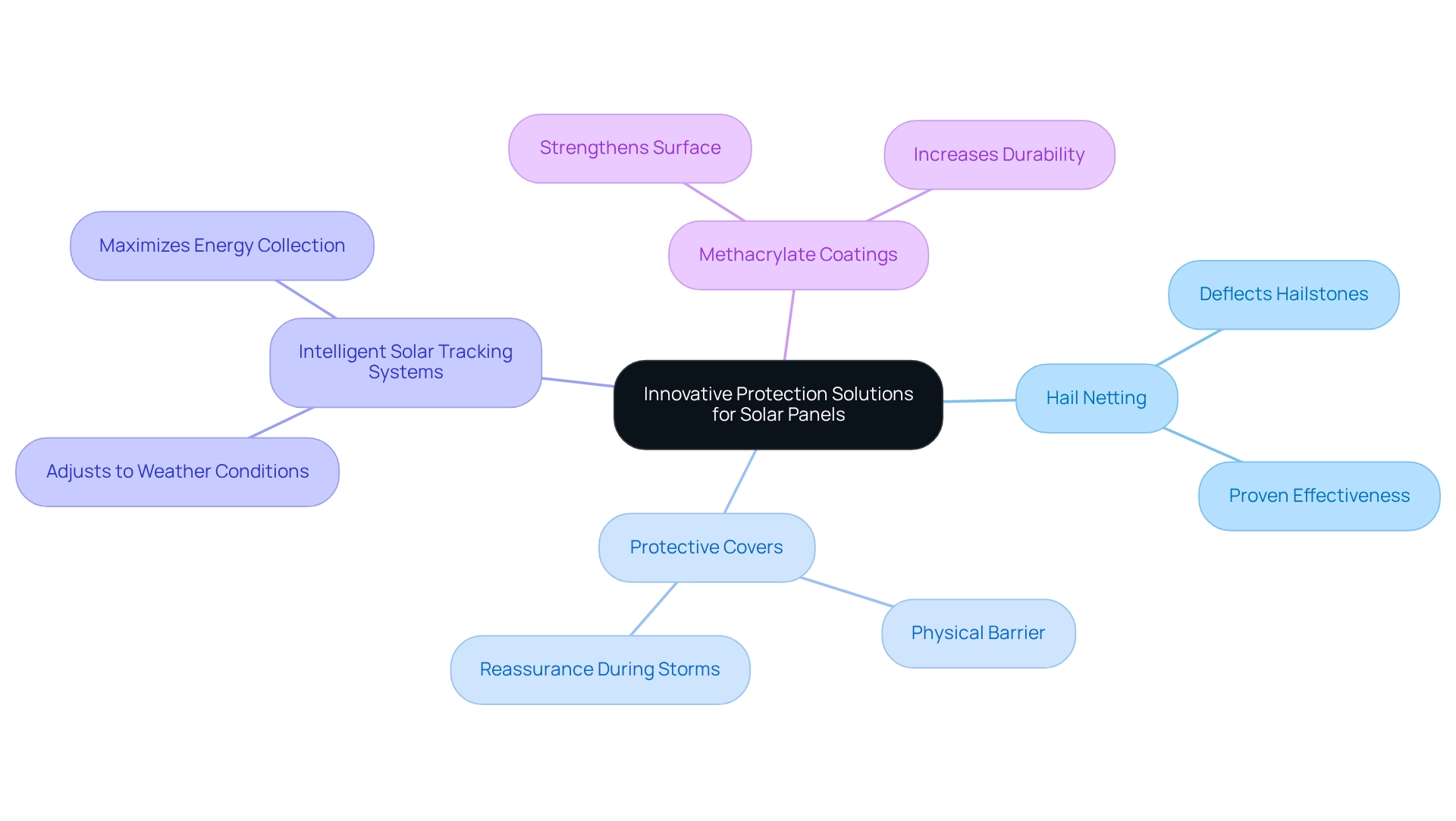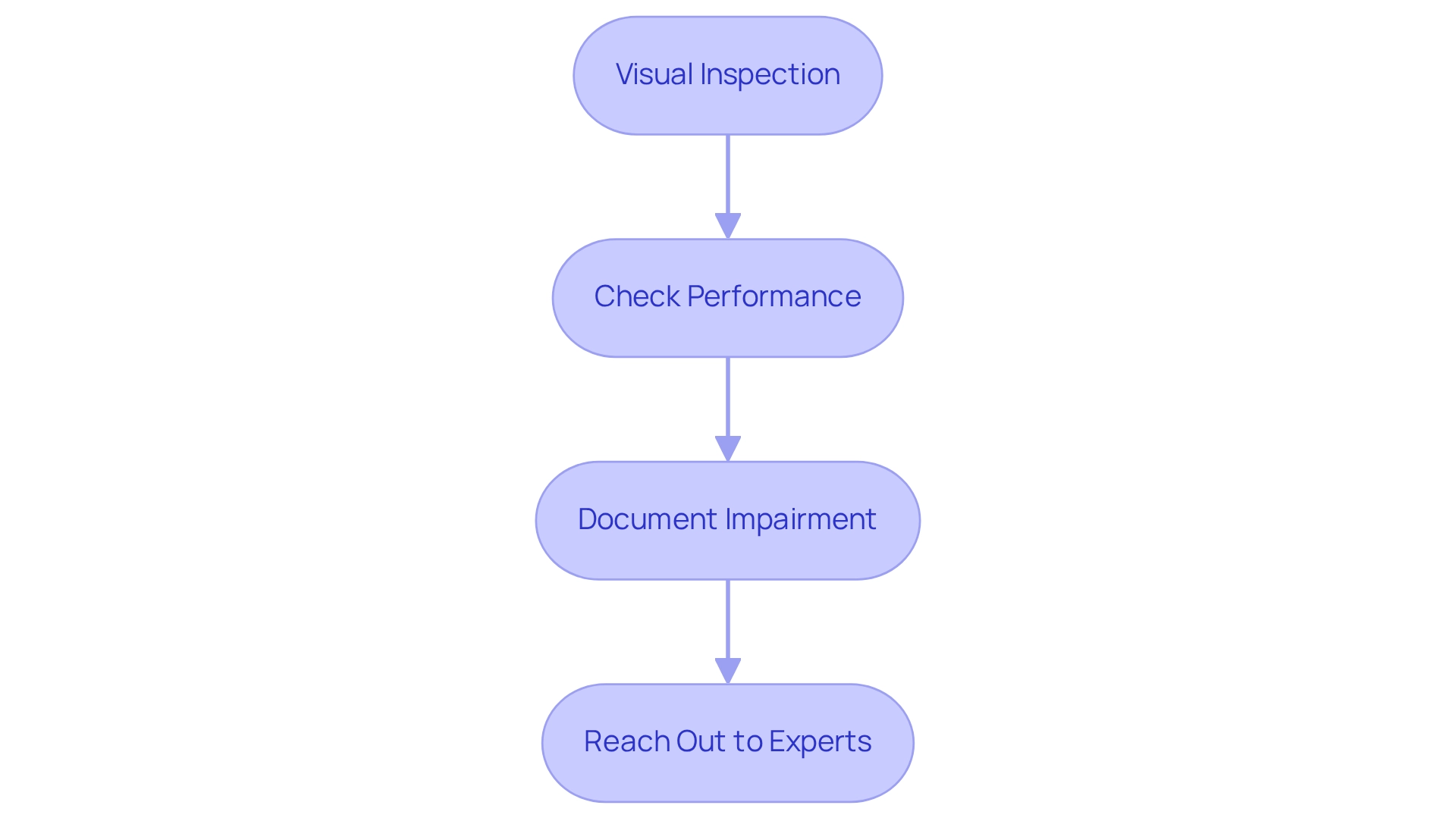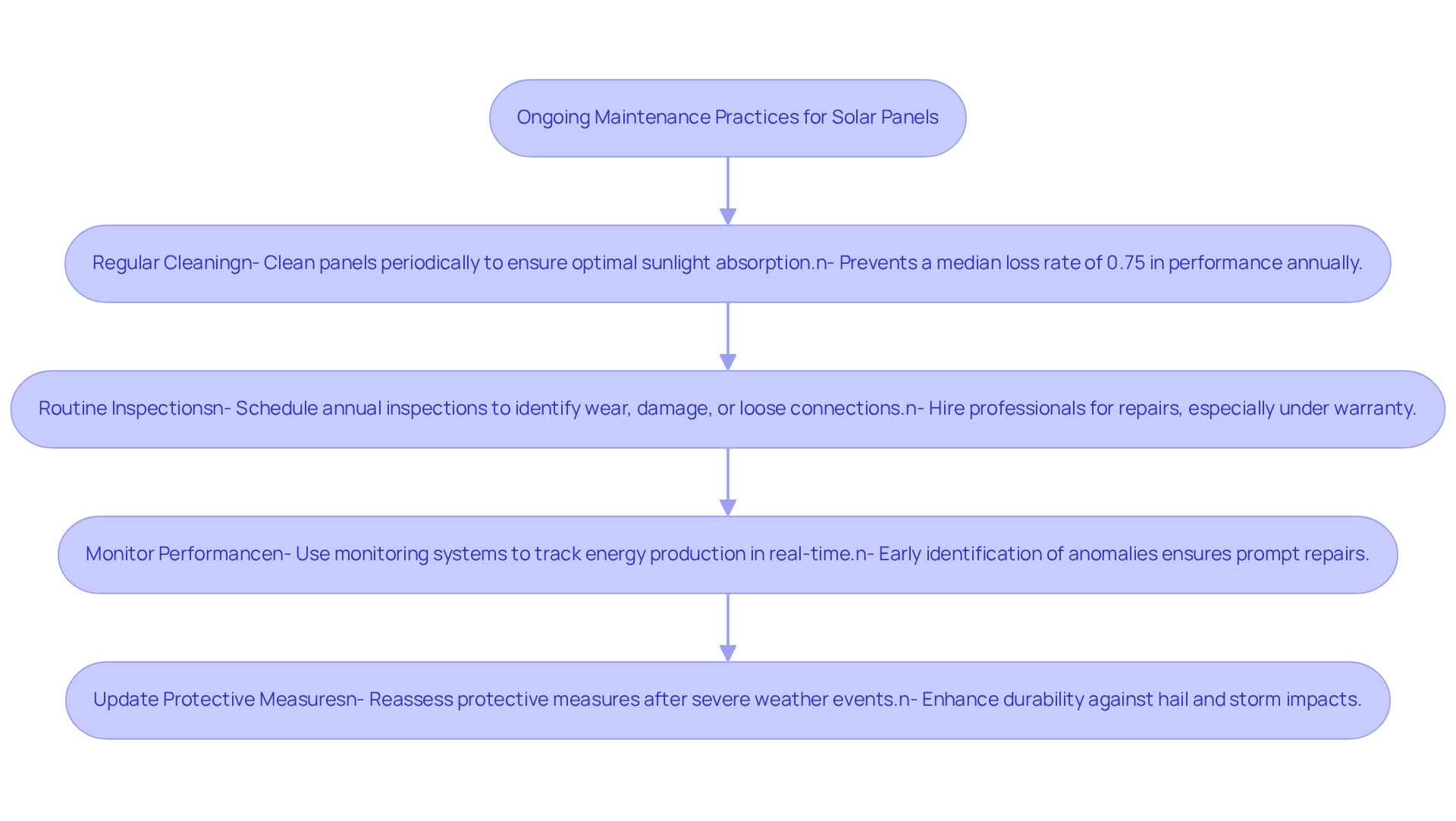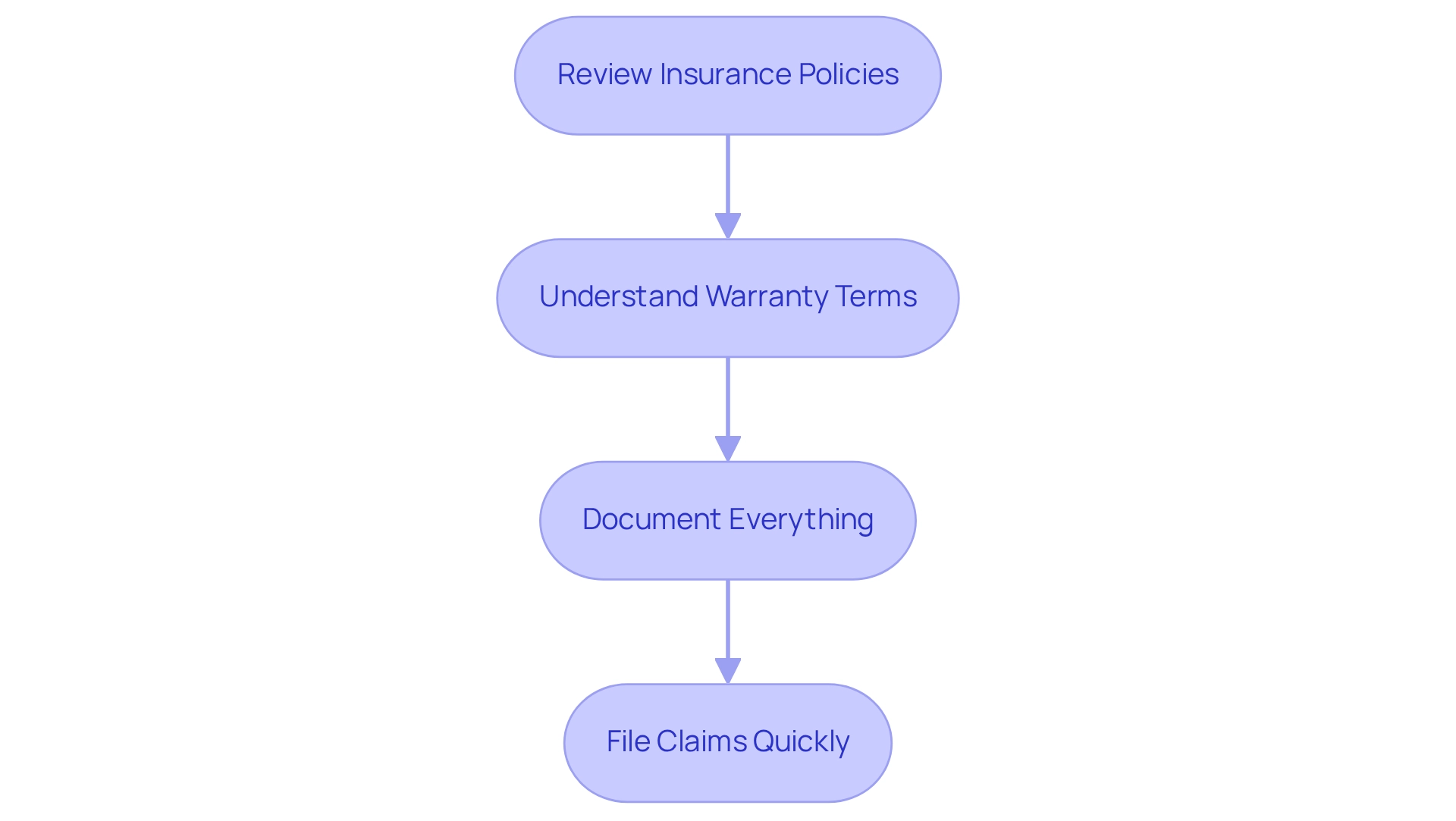Overview
We understand that protecting your solar panels from hail is a significant concern for many homeowners. To ease your worries, consider implementing proactive strategies such as:
- Installing protective covers
- Conducting regular maintenance
- Monitoring weather conditions
These measures not only safeguard your investment but also ensure the efficiency of your solar energy systems. Additionally, selecting durable panels that meet safety standards can significantly mitigate the risks of hail damage. Together, we can work towards maintaining the integrity of your solar energy system and ensuring your peace of mind.
Introduction
In regions where severe weather is a common occurrence, we understand that the threat of hail can pose significant risks to solar panels, impacting both their performance and longevity. As homeowners increasingly invest in solar energy, it’s crucial to grasp the potential damage from hail. This article delves into the various dimensions of hail damage, exploring the risks, the durability of solar panels, and innovative protective solutions available.
With expert insights and practical strategies, homeowners can learn how to safeguard their investments against hail and ensure their solar systems remain efficient and reliable. By being proactive and informed, together we can navigate the challenges posed by nature while maximizing the benefits of clean energy.
Let’s work towards a sustainable future, ensuring your home remains a beacon of energy independence.
Understanding Hail Damage: Risks to Solar Panels
Hail poses significant risks to photovoltaic panels, making it essential for homeowners to consider solar panel protection, especially in regions prone to extreme weather. The impact of hailstones can lead to visible damage, such as cracks or dents, as well as hidden issues like micro-cracking within the photovoltaic cells. Understanding these risks is vital for homeowners who wish to protect their investments in solar energy.
For example, hailstones can vary dramatically in size, with larger stones having the potential to cause more severe damage. It’s important for property owners to familiarize themselves with the common sizes of ice pellets in their area and assess the possible impacts on their energy systems.
Recent studies show that photovoltaic modules installed in the United States must adhere to the latest UL 61730 safety requirements, which focus on the durability of panels against environmental factors, including ice. This compliance is crucial for ensuring that solar energy systems are adequately protected from hail, allowing them to withstand severe weather impacts and safeguard homeowners’ investments.
Practical examples highlight the effects of precipitation damage. A case study titled “Risks Associated with Solar Panel Installations” revealed that many homeowners were unaware of the full range of risks linked to both roof-mounted and ground-mounted systems. A forensic examination of various incidents indicated that ice precipitation issues could lead to significant performance declines, ultimately affecting energy output and increasing repair costs.
Expert opinions also emphasize the importance of pre-construction risk assessments, particularly regarding solar panel protection from hail in hail-prone areas. Dan Schreiber, a Certified Consulting Meteorologist with extensive experience in legal and insurance matters related to weather events, emphasizes that thorough assessments and expert consultations are essential for mitigating risks associated with precipitation-related damage. His insights reinforce the need for homeowners to proactively understand and address these risks.
Data suggest that ice damage can severely impact the performance of energy collectors, leading to reduced efficiency and potential financial losses. By taking the necessary precautions and staying informed about local weather patterns, homeowners can better protect their energy investments from the detrimental effects of ice.
The Durability of Solar Panels: Are They Hail-Resistant?
We understand that as homeowners, concerns about energy bills and the safety of your solar panels are paramount. Contemporary solar modules are thoughtfully designed with features that protect against hail and withstand a variety of environmental challenges, including severe weather. Most structures undergo rigorous testing to ensure they can endure hailstones up to 1 inch in diameter, impacting at speeds of 50 miles per hour. This level of testing assures you that your solar panels can handle normal weather conditions without sustaining significant damage.
Moreover, structures made with thicker glass—available in thicknesses of 2.8 mm, 3.2 mm, and 4 mm—provide enhanced protection against ice projectiles.
When selecting solar panels, it’s essential to prioritize those that carry certifications such as UL 61730, indicating successful completion of rigorous impact tests. Recent research emphasizes the importance of more comprehensive testing procedures that accurately replicate severe storm conditions, as current IEC standards may not fully reflect real-world scenarios. As Nallapaneni Manoj Kumar noted, “This paper examined the impact of precipitation on PV modules of varying thicknesses considering more extensive testing beyond the IEC test that clearly represents and analyzes the durability of PV modules installed.”
Before exploring photovoltaic systems, we encourage you to look for potential hazards, such as fallen power lines, to ensure your safety. Expert opinions stress that the resilience of photovoltaic modules against hail is crucial for protection and depends not only on thickness but also on the materials used in their construction. Manufacturers highlight that reinforced materials can significantly enhance durability, safeguarding your solar investment.
Additionally, employing professional solar panel cleaning services, such as Sunshine Cleaners, Solar Shine, and Eco-Solar Clean, can greatly improve the efficiency and lifespan of your solar panels. These services prevent corrosion and buildup, which can worsen the effects of hail. Regular maintenance, including safe cleaning methods, is vital for ensuring optimal energy efficiency and protecting against damage from dirt and debris.
Neglecting this maintenance can lead to a reliance on grid energy, ultimately increasing your carbon footprint. By taking a proactive approach, you not only protect your investment but also contribute to a cleaner environment, ensuring that your systems operate at peak efficiency.
In summary, while many energy systems are designed to withstand ice, choosing the right product and ensuring proper upkeep through expert cleaning services are essential for protecting your solar panels from hail. Together, we can work towards a more sustainable future, ensuring your solar energy system remains efficient and reliable.
Preventative Strategies: How to Protect Solar Panels Before Hail Strikes
To effectively safeguard your solar panels from hail damage, it’s important to consider several proactive strategies that can bring you peace of mind:
-
Install Protective Covers: When severe weather is on the horizon, utilizing temporary protective covers or tarps can significantly mitigate damage. These covers act as a buffer, absorbing impacts and preventing direct contact between hailstones and your energy collection surfaces.
-
Choose the Right Site: Selecting locations for your solar systems that are less prone to severe weather can be advantageous. By placing screens near natural obstacles, like trees or structures, you enhance the protection of your solar panels from hail, providing an extra layer of defense against hailstorms.
-
Regular Maintenance: Conducting routine inspections is crucial. It’s essential to ensure that all structures are firmly attached and to look for any signs of wear or damage that could worsen during severe weather. Regular upkeep not only extends the lifespan of your solar panels but also boosts their resilience against harsh conditions. Understanding your photovoltaic technology is vital for effective solar panel protection from hail and maximizing energy efficiency.
-
Monitor Weather Conditions: Staying informed about weather forecasts is key. Being prepared to take protective actions, including safeguarding your solar panels from hail, ensures your energy systems remain secure when extreme weather is expected.
In addition to these measures, introducing a stow feature for tracker systems has proven effective in reducing damage during severe weather. Brian Allen, a senior risk engineer with Aon Global Risk Consulting Services, notes that “for loss modeling scenarios, PML versus EML, there is benefit (reduction of risk) from the use of stowage systems.” This expert insight highlights the importance of proactive management.
A case study titled ‘Hail Event Protocol for Solar Systems’ emphasizes the significance of thorough inspections for electrical faults after hail events. It shows that effective solar panel protection from hail through proactive management can significantly reduce risks. In fact, in 2024, Evalence completed 55 energy installations without any occurrences of storm damage, demonstrating the success of these preventative strategies.
By adopting these practices, you can safeguard your energy investments and ensure the longevity and safety of your energy solutions against severe storms. Moreover, understanding ideal battery options for energy storage and exploring innovative cleaning solutions can further enhance the efficiency and lifespan of your photovoltaic systems. Together, we can work towards a more secure and sustainable energy future.
Innovative Protection Solutions: Products to Shield Your Solar Panels
We understand that as a homeowner, concerns about energy bills can weigh heavily on your mind. The good news is that there are innovative solutions available to safeguard your solar investment from the unpredictable forces of nature, particularly hail damage. By exploring these options, you can enhance the durability and resilience of your solar panels, ensuring they continue to serve you well.
-
Hail Netting: Imagine a strong netting positioned above your photovoltaic modules, effectively deflecting hailstones and minimizing their impact. This reliable first line of defense has been proven in various installations, giving you peace of mind during severe weather.
-
Protective Covers: During intense storms, hard shell covers or padded protective cases can act as a physical barrier, shielding your photovoltaic surfaces from ice pellets. These covers are especially beneficial for those living in areas prone to hailstorms, offering not just protection but also reassurance.
-
Intelligent Solar Tracking Systems: Consider sophisticated tracking systems that adjust the angle of your photovoltaic modules in response to changing weather conditions. By reducing exposure to severe weather, these systems not only protect your panels but also enhance energy collection during milder conditions, allowing you to maximize your investment.
-
Methacrylate Coatings: Applying a methacrylate coating can significantly strengthen the surface of your photovoltaic devices, making them more resistant to impacts. This creative solution not only shields against severe weather but also prolongs the overall durability of your solar investment.
Recent studies highlight the importance of considering risks from ice storms in financial models for solar initiatives, especially in light of climate change and its potential impact on storm frequency. It’s worth noting that the majority of system costs are no longer tied solely to the panels, underscoring the financial benefits of investing in protective measures.
As Jon Previtali, Vice President of Digital Services and Product Manager for Hail Risk Intelligence, wisely points out, “Although we’re still working on the best way to do it, the effects of climate change and the El Nino Southern Oscillation (ENSO) cycle should be considered to bookend estimated losses over a project’s lifetime.” By embracing these innovative products and strategies, you can ensure that your energy investments are well-protected against the elements.
Let’s work together to safeguard your solar panels. Powercore Electric’s dedicated team of specialists is here to provide top-notch installations and maintenance, establishing themselves as a reliable partner for your energy and electrical needs in California.
Post-Hail Storm Actions: Assessing and Responding to Damage
After a hail storm, we understand that homeowners may feel anxious about the condition of their solar panels. To help you assess and respond to any potential damage, we recommend following these essential steps:
-
Visual Inspection: Begin with a thorough assessment of your panels for any visible signs of harm, such as cracks, dents, or shattered glass. It’s important to look for any irregularities that could affect performance.
-
Check Performance: Utilize your inverter or monitoring app to track the system’s performance. A significant drop in energy production may indicate underlying issues that need your attention.
-
Document Impairment: Take clear photographs and detailed notes of any visible harm. This documentation is crucial for insurance claims or warranty purposes, ensuring you have a complete record of your photovoltaic panels’ condition.
-
Reach Out to Experts: If you suspect any damage, don’t hesitate to contact a certified technician, like those from Powercore Electric, for a comprehensive evaluation. Their expertise is invaluable in accurately assessing the extent of the damage and suggesting appropriate repairs.
In terms of statistics, solar modules with a front glass thickness of 4 mm have shown remarkable resilience, losing only 1.1% of their power output after impact tests. This highlights the significance of panel design in protecting solar panels from hailstorms. As Cherif Kedir, President & CEO of RETC, LLC, notes, “the construction and treatment of the module significantly influence the durability testing results—specifically, how much tempering the module glass underwent during manufacturing, the thickness of the module glass, and the angle of the impact on the module.”
Real-world instances illustrate that comprehensive evaluations, often employing aerial imagery alongside ground assessments, can effectively measure the effects of severe weather events on photovoltaic modules and related infrastructure. The case study titled ‘Best Practices for Evaluating Hail Damage in Solar Farms’ emphasizes the importance of thorough inspections and testing for solar panel protection from hail, which can enhance the guidance provided to homeowners.
By following these steps and leveraging expert guidance from Powercore Electric’s in-house team, you can ensure your energy systems remain durable and efficient, even in the face of severe weather. Powercore Electric is committed to providing high-quality installations and maintenance, offering additional support for homeowners in the aftermath of hail damage. For more information or assistance, please contact Powercore Electric at ryan.serrano@powercoreinc.net or call (916) 699-8778.
Ongoing Maintenance: Keeping Your Solar Panels Safe and Efficient
To ensure the safety and effectiveness of photovoltaic systems, we understand that homeowners may feel overwhelmed by the need for continuous upkeep. Embracing a thorough strategy can help alleviate these concerns and enhance the longevity of your investment. Here are some essential practices to consider:
-
Regular Cleaning: It’s important to clean your photovoltaic panels periodically. Dust, dirt, and debris can obstruct sunlight and reduce energy production. A clean surface allows for optimal sunlight absorption, which is crucial for maintaining efficiency. As Sarah Kurtz, a professor at the University of California, Merced, notes, regular cleaning is vital for high performance in photovoltaic technology. If you notice a significant drop in energy production, cleaning the surface is often the first step to resolving the issue. Research indicates that neglecting this maintenance can lead to a median loss rate of 0.75% in performance annually, underscoring the need for routine care. Additionally, scientists from the Indian Institute of Engineering Science and Technology have created a model to assess dust buildup on solar surfaces, helping determine the frequency of cleaning based on environmental conditions.
-
Routine Inspections: Scheduling annual inspections with a qualified professional is essential. These inspections should focus on identifying signs of wear, damage, or loose connections that could compromise your system’s performance. Regular evaluations ensure that any potential concerns are addressed swiftly, prolonging the durability of your panels. It’s advisable to hire professionals for repairs or replacements, especially for panels under warranty, as their expertise is crucial for maintaining efficiency and safety.
-
Monitor Performance: Utilizing monitoring systems allows homeowners to track energy production in real-time. This proactive approach helps in the early identification of anomalies that may indicate harm or inefficiencies, ensuring that necessary repairs can be conducted promptly. This is particularly important in warmer climates where environmental factors can impact the reliability of photovoltaic systems.
-
Update Protective Measures: After experiencing severe weather events, it’s crucial to reassess your existing protective measures. Property owners should make necessary modifications to enhance the durability of their energy systems against future severe weather or storm impacts. This is especially pertinent considering the risk of hail damage, highlighting the importance of protecting solar panels to ensure their longevity and safety.
Implementing these maintenance practices not only protects your solar panels from hail but also safeguards your investment in this technology while aiding in energy efficiency and sustainability. Statistics suggest that a good warranty for energy systems typically lasts between 15 and 25 years, ensuring energy output remains at 80% or higher. Routine upkeep can significantly enhance the efficiency and lifespan of photovoltaic systems, ensuring they operate at peak levels for years to come.
By prioritizing these practices, you can enjoy the benefits of clean energy while protecting your systems from potential hazards. Together, we can ensure that your photovoltaic systems remain efficient and reliable. Powercore Electric’s community-centered approach guarantees that you receive dedicated support in implementing these essential maintenance practices.
Insurance and Warranties: Financial Protection Against Hail Damage
As a homeowner, ensuring that your solar panels are adequately covered against hail damage is essential for protecting your investment. Here are some thoughtful steps to help you navigate this important aspect of solar energy management:
-
Review Insurance Policies: It’s crucial to confirm that your homeowner’s insurance provides protection for damage to rooftop systems. Many standard policies may not automatically cover this risk, and additional coverage might be necessary. Did you know that homeowners who actively modify their policies can save significantly on repair expenses in the event of severe weather? As Jaeyong Lee from Geosystem Research Corporation wisely notes, “The paper reflects the views of the scientists, and not the Corporation,” reminding us that understanding the nuances of insurance coverage is vital.
-
Understand Warranty Terms: Not all solar panel warranties include coverage against precipitation damage. Take the time to thoroughly review your warranty documentation to identify specific terms related to storm protection. Warranties that explicitly mention solar panel protection from hail can offer you peace of mind and financial security.
-
Document Everything: Keeping comprehensive records of your solar energy system installation is essential. This includes receipts, warranty documents, and records of any inspections or maintenance performed. Such documentation can be invaluable when submitting claims, as it supports your ownership and the condition of the items before any harm occurs.
-
File Claims Quickly: If severe weather impacts your solar panels, it’s important to submit insurance claims as soon as possible. Supplying all required documentation, including images of the damage and records of your energy system installation, can help expedite the claims process. Expert advice suggests that timely claims can lead to quicker resolutions and better outcomes for homeowners. The ANELFA Network for Precipitation Prevention in France serves as a case study, showcasing coordinated efforts to safeguard against meteorological harm, which is also relevant for panel protection.
By following these guidelines, you can more effectively ensure that your solar panels are protected from hail and safeguard your investments in solar energy against potential damage from severe weather. With improving techniques to measure and forecast hail precipitation, the reliability of hail forecasts is increasing, making adequate coverage even more critical. This information is timely, as highlighted in the article authored by David Gambrill divider, published on March 18, 2025.
Conclusion
Understanding the risks posed by hail to solar panels is essential for homeowners who prioritize renewable energy. We recognize that hail can cause both visible and hidden damage, impacting performance and longevity. It’s crucial to select durable solar panels that comply with safety standards, such as UL 61730. Moreover, proactive measures, including regular maintenance and inspections, are vital to mitigate potential damage.
Implementing preventative strategies, such as installing protective covers and monitoring weather conditions, can significantly enhance the resilience of solar systems against hail. Innovative protection solutions like hail netting and smart solar tracking systems offer effective ways to shield solar panels from severe weather impacts. By combining these strategies with ongoing maintenance practices, homeowners can ensure their solar installations remain efficient and reliable despite the challenges posed by nature.
Ultimately, safeguarding solar investments requires a comprehensive approach that includes understanding risks, selecting the right products, and maintaining them diligently. We understand that taking these steps can feel overwhelming, but by staying informed and taking proactive actions, you can protect your energy independence and contribute to a sustainable future. The integration of robust protective measures and financial safeguards, such as appropriate insurance coverage and warranties, further enhances the durability and performance of solar energy systems, ensuring they continue to provide clean energy for years to come. Together, we can foster a resilient and sustainable energy future.



